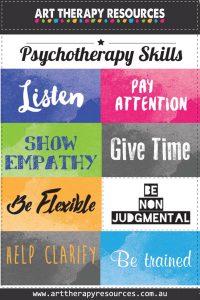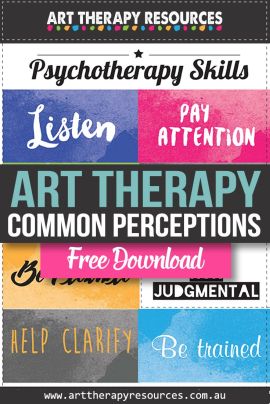THIS POST INCLUDES:
1. Introduction
2. Functions of Art Therapy
3. Common Perceptions of Art Therapy
4. Free Download Psychotherapy Skills
INTRODUCTION
When individuals seek mental health services, they often rely on word of mouth, online research, or social media discussions to inform their choices. Understanding the public’s perception of art therapy is vital because it directly affects whether potential clients consider this form of therapy. Misconceptions or negative biases can dissuade people from trying art therapy, even if it might be highly beneficial for them.
Knowing what the public expects from art therapy can help therapists set realistic expectations. Art therapy is a unique modality, and clients who understand its objectives are more likely to engage actively and stay committed to the process. Clear communication about what art therapy entails can improve client satisfaction and the likelihood of positive outcomes.
Public perception influences how art therapy is integrated into mental healthcare systems. Positive public opinion can lead to greater recognition and acceptance within mainstream healthcare. This, in turn, could result in more opportunities for art therapists to work alongside other mental health professionals, providing a more holistic approach to treatment.
Public support often translates into research funding and resources. When art therapy is well-regarded, research initiatives to explore its efficacy and potential applications are more likely to receive funding. This research not only advances the profession but also provides evidence of its effectiveness, further enhancing public perception.
Art therapy can be particularly effective in addressing mental health issues, but stigma surrounding mental health remains a significant barrier to seeking help. Public discussions about art therapy can contribute to reducing this stigma by highlighting its role in promoting mental well-being and providing a safe space for self-expression.
Public conversations can help dispel myths and misconceptions about art therapy. When individuals share their positive experiences or when professionals clarify how art therapy works, it contributes to a more accurate understanding of the field.
Art therapists play a crucial role in educating the public about their profession. Engaging in outreach efforts, sharing informative content online, and participating in community events are ways to raise awareness about art therapy and its benefits.
Positive public perception can lead to increased demand for art therapy services. Art therapists can leverage this demand to advocate for greater access to their services in schools, hospitals, correctional facilities, and other settings where mental health support is needed.
The perception and portrayal of art therapy in the public sphere have profound implications for both the well-being of individuals seeking therapy and the growth and recognition of the profession. Art therapists and advocates must actively engage with the public to foster understanding, dispel myths, and promote the invaluable role of art therapy in mental health care. Understanding how the public perceives and discusses art therapy is crucial, as it influences both client satisfaction and the advancement of the profession.
FUNCTIONS OF ART THERAPY
Art therapy involves complex interactions between clients, art therapists, and the artwork itself. While it may appear simplistic on the surface, art therapists undergo extensive training to navigate the psychological dimensions of the therapeutic process. Client satisfaction plays a crucial role in the credibility of the profession, as satisfied clients are more likely to engage in art therapy programs.
Public perceptions of art therapy can be mixed. Some view it as a valuable non-verbal form of self-expression, especially for trauma survivors who struggle to articulate their emotions verbally. Others are sceptical due to the subjective nature of art therapy and the perception of a lack of concrete scientific evidence. It’s crucial to address these perceptions to bridge the gap between public understanding and the practice of art therapy.
Client Satisfaction and Confidence
Client satisfaction is at the core of any successful therapeutic intervention. When individuals seek out art therapy, their perceptions and expectations play a pivotal role in determining their satisfaction with the services they receive. Positive public perceptions can bolster a client’s confidence in art therapy as a legitimate and effective form of mental health support. When clients believe in the process and its potential benefits, they are more likely to actively engage in therapy, which can lead to better outcomes.
On the flip side, negative or misinformed perceptions can undermine this confidence. If potential clients are sceptical or misinformed about art therapy, they may be less likely to explore it as an option for addressing their mental health needs. This can lead to missed opportunities for individuals who could potentially benefit from art therapy but are deterred by misconceptions or scepticism.
Advancement of the Profession
Public perception also plays a crucial role in the advancement and recognition of the art therapy profession. The field of mental health is continually evolving, and the level of recognition and acceptance of art therapy within this broader landscape is influenced by how it is perceived by the public.
Positive public perceptions can foster a greater demand for art therapy services, potentially leading to increased funding and support from healthcare institutions and policymakers. When art therapy is seen as a valuable and credible form of mental health support, it is more likely to be integrated into healthcare systems and offered as a standard option for individuals seeking help.
Conversely, if art therapy is misunderstood or undervalued by the public, it may face challenges in gaining the recognition it deserves. This could result in limited access to art therapy services, reduced research funding, and fewer opportunities for art therapists to practice within diverse healthcare settings.
The Role of Education and Advocacy
Art therapists have a vital role to play in educating the public and advocating for their profession. Providing accurate information about art therapy, its benefits, and the conditions it can effectively address is essential. Art therapists can engage in outreach efforts, both online and offline, to raise awareness about their field and dispel misconceptions.
Additionally, sharing success stories and client testimonials can be a powerful way to showcase the real-world impact of art therapy. When the public sees tangible evidence of how art therapy has positively transformed lives, it can help reshape perceptions and promote greater acceptance of the practice.
COMMON PERCEPTIONS OF ART THERAPY
Some of the common perceptions held about art therapy include:
1. Art therapy enables non-verbal self-expression: there is an understanding that art therapy encourages expression of emotions and thoughts through non-verbal means
2. Art therapy does not work objectively: assumptions that art therapy is subjective and that it does not rely on objective analysis but rather taps into the mysteries of human emotions
3. Art therapy opens up fragile emotions: art therapy could bring forward deeply buried emotions, which is essential for healing but can also be distressing to experience
4. Art therapy is an under-recognized field: art therapy is not widely available in healthcare systems, and clients often face difficulties in obtaining reimbursement for art therapy services.
5. Art therapy helps when other treatments fail: art therapy has been viewed by some as a last resort after other treatments have been unsuccessful. Some have attached the statement of ‘well, it can’t hurt’ to the use of art therapy.
6. Art therapy is about the creative process: The creative process is emphasized as a crucial aspect of art therapy, focusing on personal experiences during the creative journey.
7. Art therapy is a form of reprieve: art therapy can be viewed as a form of relief from symptoms, providing an escape from daily challenges.
Public perceptions of art therapy are diverse. While many recognize its potential for non-verbal self-expression and emotional exploration, others question its objectivity and scientific basis. Some perceive it as an underutilized field, while others turn to it as a last resort after other treatments fail.
These findings underscore the need for providing credible information about art therapy online. Art therapists should take the lead in developing and disseminating accurate and accessible information about art therapy. This includes creating an evidence base that supports current art therapy practices and developing strategies for sharing this information with the public.
Moreover, addressing client expectations is crucial. Art therapists should be proactive in clarifying what clients can expect from art therapy and discussing anticipated progress, especially in the early stages of therapy.
FREE DOWNLOAD: Art Therapy Exercise
SIGN UP below to gain access to our RESOURCE LIBRARY and download the FREE Psychotherapy Skills Handout.

BUILD YOUR ART THERAPY REFERENCE MATERIALS:
Pin this image to your Pinterest board.

SHARE KNOWLEDGE & PASS IT ON:
If you’ve enjoyed this post, please share it on Facebook, Twitter, Pinterest. Thank you!
